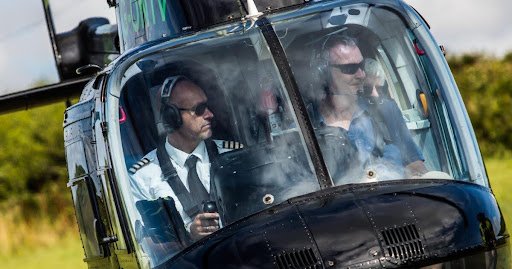Have you ever gazed up at the sky, mesmerized by the graceful flight of a helicopter? Have you dreamt of soaring through the clouds, controlling a machine that defies gravity? If so, you’re not alone. The allure of helicopter piloting is undeniable, offering a unique blend of skill, knowledge, and exhilaration.
In this comprehensive guide, we’ll delve into the intricacies of becoming a helicopter pilot. From understanding the fundamentals of flight to navigating the licensing process, we’ll cover every aspect of this exciting journey.
The Basics of Helicopter Flight
Before we dive into the specifics of training, let’s explore the fundamental principles of helicopter flight. Unlike fixed-wing aircraft, helicopters rely on rotating blades, or rotors, to generate both lift and thrust.
Rotor System: The main rotor, located on top of the helicopter, is responsible for lifting the aircraft into the air. The tail rotor, positioned at the rear, counteracts the torque produced by the main rotor, preventing the helicopter from spinning uncontrollably.
Controls: Helicopter pilots use a cyclic control, collective pitch control, and rudder pedals to maneuver the aircraft. The cyclic control tilts the rotor disk forward, backward, left, or right, causing the helicopter to move in the corresponding direction. The collective pitch control adjusts the angle of attack of all the rotor blades simultaneously, controlling the helicopter’s altitude. The rudder pedals control the tail rotor, allowing the pilot to yaw the helicopter left or right.
The Licensing Process
To become a certified helicopter pilot, you’ll need to obtain a pilot’s license from the appropriate aviation authority. The specific requirements may vary depending on your location, but the general process involves the following steps:
Medical Certification: You’ll need to undergo a medical examination to ensure you’re physically fit to fly. The specific medical standards vary depending on the type of license you’re seeking.
Written Exam: Aerodynamics, aircraft systems, meteorology, navigation, and rules are just a few of the many subjects covered in this exam.
Practical Exam: The practical exam, also known as a flight test, assesses your flying skills. You’ll be required to demonstrate proficiency in various maneuvers, such as takeoffs, landings, hovering, and emergency procedures.
The Training Experience
WonderDays Helicopter flight training typically takes place at a certified flight school. The training program is tailored to your individual needs and experience level. Here’s a broad outline of what to anticipate:
Ground School: This phase of training focuses on theoretical knowledge, including aerodynamics, aircraft systems, meteorology, navigation, and regulations.
Flight Training: This is where you’ll spend most of your time, learning to fly the helicopter under the guidance of experienced flight instructors. You’ll start with basic maneuvers, such as hovering and taxiing, and gradually progress to more advanced techniques, such as cross-country flights and instrument flying.
The Costs of Becoming a Helicopter Pilot
The cost of obtaining a helicopter pilot’s license can vary significantly depending on various factors, such as the type of helicopter, the flight school, and your location. However, you can expect to spend a substantial amount of money on tuition, flight time, and licensing fees.
Career Paths for Helicopter Pilots
Once you’ve obtained your pilot’s license, you’ll have a variety of career options to choose from. Here are a few popular career paths:
Commercial Pilot: Commercial helicopter pilots work for airlines, charter companies, or other organizations that operate helicopters for commercial purposes.
Corporate Pilot: Corporate pilots fly helicopters for wealthy individuals or corporations.
Government Pilot: Government pilots work for various government agencies, such as law enforcement, emergency services, and military.
Flight Instructor: Flight instructors teach aspiring pilots how to fly helicopters.
The Rewards of Becoming a Helicopter Pilot
The journey to becoming a helicopter pilot is undoubtedly challenging, but the rewards are immense. The thrill of flying a helicopter is unparalleled, and the sense of accomplishment is immeasurable. As a helicopter pilot, you’ll have the opportunity to explore stunning landscapes, assist in search and rescue missions, and experience the world from a unique perspective.
FAQs
How much does it cost to become a helicopter pilot?
The cost of becoming a helicopter pilot varies depending on several factors, including location, flight school, and the type of license you’re pursuing. However, you can expect to spend a significant amount on tuition, flight time, and licensing fees.
How long does it take to become a helicopter pilot?
The time required to become a helicopter pilot depends on factors such as your experience level, the intensity of your training, and the type of license you’re seeking. A private pilot license typically takes several months to a year to obtain.
What are the physical requirements to become a helicopter pilot?
To become a helicopter pilot, you must meet certain physical standards. You’ll need to undergo a medical examination to ensure you’re physically fit to fly. The specific medical requirements may vary depending on the type of license you’re seeking.
Do I need a college degree to become a helicopter pilot?
A college degree is not a strict requirement to become a helicopter pilot. However, a degree in aviation or a related field can be beneficial, especially if you’re pursuing a career as a commercial or airline pilot.
What are the age requirements to become a helicopter pilot?
You must be at least 17 years old to obtain a private pilot’s license. For a commercial pilot’s license, you must be at least 18 years old.
Final Thoughts
Many people aspire to be helicopter pilots. With dedication, hard work, and a passion for flying, you can turn that dream into a reality. By understanding the fundamentals of helicopter flight, the licensing process, and the training involved, you can embark on this exciting journey and soar to new heights.
